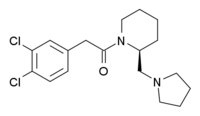BRL-52537
BRL-52537 is a drug which acts as a potent and highly selective κ-opioid agonist.[1] It has neuroprotective effects in animal studies,[2][3] and is used for research into potential treatments for stroke and heart attack as well as more general brain research.[4][5][6]
 | |
| Identifiers | |
|---|---|
IUPAC name
| |
| CAS Number | |
| PubChem CID | |
| ChemSpider | |
| Chemical and physical data | |
| Formula | C18H24Cl2N2O |
| Molar mass | 355.301 g/mol g·mol−1 |
| 3D model (JSmol) | |
SMILES
| |
InChI
| |
| | |
References
- Vecchietti V, Giordani A, Giardina G, Colle R, Clarke GD (January 1991). "(2S)-1-(arylacetyl)-2-(aminomethyl)piperidine derivatives: novel, highly selective kappa opioid analgesics". Journal of Medicinal Chemistry. 34 (1): 397–403. doi:10.1021/jm00105a061. PMID 1846921.
- Goyagi T, Toung TJ, Kirsch JR, Traystman RJ, Koehler RC, Hurn PD, Bhardwaj A (June 2003). "Neuroprotective kappa-opioid receptor agonist BRL 52537 attenuates ischemia-evoked nitric oxide production in vivo in rats". Stroke: A Journal of Cerebral Circulation. 34 (6): 1533–8. doi:10.1161/01.STR.0000072512.30658.E7. PMID 12738895.
- Zhang Z, Chen TY, Kirsch JR, Toung TJ, Traystman RJ, Koehler RC, Hurn PD, Bhardwaj A (December 2003). "Kappa-opioid receptor selectivity for ischemic neuroprotection with BRL 52537 in rats". Anesthesia and Analgesia. 97 (6): 1776–83. doi:10.1213/01.ane.0000087800.56290.2e. PMID 14633559.
- Chen TY, Goyagi T, Toung TJ, Kirsch JR, Hurn PD, Koehler RC, Bhardwaj A (May 2004). "Prolonged opportunity for ischemic neuroprotection with selective kappa-opioid receptor agonist in rats". Stroke: A Journal of Cerebral Circulation. 35 (5): 1180–5. doi:10.1161/01.STR.0000125011.93188.c6. PMID 15031456.
- Peart JN, Gross ER, Gross GJ (March 2004). "Effect of exogenous kappa-opioid receptor activation in rat model of myocardial infarction". Journal of Cardiovascular Pharmacology. 43 (3): 410–5. doi:10.1097/00005344-200403000-00012. PMID 15076225.
- Britt JP, McGehee DS (February 2008). "Presynaptic opioid and nicotinic receptor modulation of dopamine overflow in the nucleus accumbens". Journal of Neuroscience. 28 (7): 1672–81. doi:10.1523/JNEUROSCI.4275-07.2008. PMID 18272687.
This article is issued from
Wikipedia.
The text is licensed under Creative
Commons - Attribution - Sharealike.
Additional terms may apply for the media files.